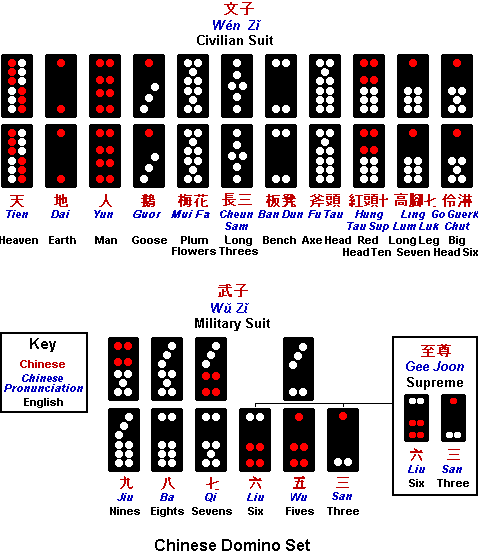|
|||||||||||||||||||||||||||||||||||||||||
|
|
|||||||||||||||||||||||||||||||||||||||||
|
Chinese Domino Suits and
Tiles L earning the suits and ranks of Chinese dominoes can be difficult for a beginner, but here you can find some helpful tips, hints and descriptions of all the tiles in a Chinese domino set that will make the learning process much easier.The suits and rankings of Chinese domino tiles are pretty much the same for most games, so once you've learnt them there will be a whole new range of domino games open for you to play. The two suits (Military and Civilian) are described separately with the corresponding individual tile descriptions found under the suit headings. It might be an idea to repeat each tile name in your head like a chant with a rhythm. This might make it easier to remember the consecutive tile values. The Civil Suit (文子) Wén Zi The Civilian suit is made up of two each of 11 different tiles (6-6, 1-1, 4-4, 1-3, 5-5, 3-3, 2-2, 5-6, 4-6, 1-6, 1-5). Note that all doubles in a Chinese domino set belong to the Civilian suit. The first thing to remember about the Civil suit rankings is that tiles DON'T rank according to the number of pips on them. Instead you must learn and understand a little about Chinese philosophical and cultural significance in nature to understand the order that Civil tiles rank and how they relate to one another. The Civil suit tiles rank from high to low in descending order as follows:
Big Head Six (伶淋六) Ling Lum Luk
(1-5)
The Military Suit (武子) Wû Zi The Military suit is made up of one each of 10 different tiles (3-6, 4-5; 2-6, 3-5; 2-5, 3-4; 2-4; 1-4, 2-3; 1-2). Note that there are no doubles in the Military suit. If you can remember the ranks of the Civil suit then the Military suit can easily be remembered by a process of elimination. The tiles you don't recognise as Civil are Military and rank according to pip total. The tiles in the Military suit rank according to the total number of pips on both ends ranking from high totals to low. The tiles have no special names and are simply referred to by their pip totals, 9s, 8s, 7s, 6, 5s, 3. The ten tiles are also considered to be five "mixed pairs" with pairs of tiles bearing the same total number of pips ranking equally. The 2-4 and 1-2 are the exceptions to the pairs rule in the Military suit and are known as an "odd pair". They are the only two tiles in the whole Chinese domino set that don't have a matching tile with the same spotted total marked on it. This odd pair rank according to their pip total when played individually but in some games they count as another suit (Gee Joon 至尊 Supreme) that ranks as the highest pair when played together.
Supreme Suit (至尊) Gee June (4-2) (1-2)
Both tiles are part of the Military suit but count as the unique separate Supreme suit when played together. The only hint on remembering their rank is that they are the only two tiles in the whole set that don't have a corresponding matching tile bearing the same number of pips.
|
||||||||||||||||||||||||||||||||||||||||
|
Copyright © 2016 Stormdark I.P. and Media. All rights reserved. www.domino-play.com This site is for personal use only and content may not be copied or reproduced in any form for any purpose. Terms & Conditions Advertising |
|||||||||||||||||||||||||||||||||||||||||

 Man (人) Yun
(4-4)
Man (人) Yun
(4-4) 
